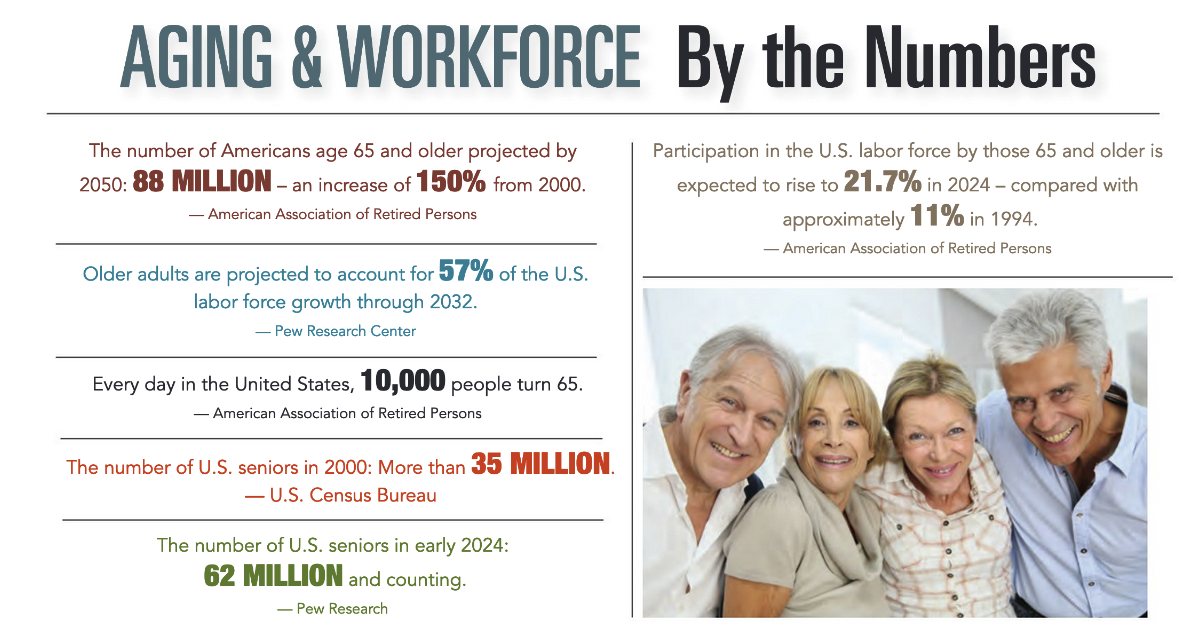When Geri Morris was forced to retire in 1998 from the Greenville Housing Authority, she was at the top of her game in every facet: pay, responsibility, performance and work ethic – often putting in 12-hour days and loving every minute of it.
Her only crime was that she had reached the age of 79, and someone in the GHA decided that she should retire after 31 years – even though pushing her out the door was illegal.
“She didn’t realize the power she had to fight the injustice, so she didn’t,” said her son, Henry J. Morris. “But I often wonder what would happen in the same circumstances now, since age discrimination in the workforce has become harder to cover.”
And it’s going to get a lot harder.
With the U.S. population continuing to age, seniors are soon going to be the largest age group in the nation; as a result, employers not only will have to find a way to keep many of them around to handle essential jobs – such as accounting, insurance, medicine, law, media, education, hospitality, and tourism – they will also likely find that an older workforce is the ready-made answer to labor shortages, high turnover and the closest they can get to long-term job loyalty.
“The increasing need for older workers in the United States is primarily the result of two factors: the general aging of the U.S. population and a nationwide labor shortage that emerged in the aftermath of the 2020 pandemic,” said Professor Joseph Von Nessen, research economist with the University of South Carolina’s Darla Moore School of Business in Columbia. “And although there are several major contributing factors that have helped create this labor shortage, the biggest is the retirement of the baby boomers.”
This wave of retirees, coupled with fewer younger workers to replace them, has left significant gaps in many professional areas – with much of the same expected before too long.
For example, the first baby boomers – born from 1946 to 1964 – qualified for retirement benefits in 2008. Since then, more than 30 million of them have retired – with Investor’s Business Daily projecting another 4.4 million to retire in 2024 alone.
Researchers with AARP International estimate that 10,000 people in the United States now turn 65 every day. And the Census Bureau is projecting older adults to outnumber children by the year 2034 for the first time in U.S. history.
The questions now: Are most retirees through the next decade simply going to be living out their growing life expectancy in some form of senior living facility? Or are they going to continue to be vital parts of the workforce? Von Nessen, for one, is betting on the latter.
“The U.S. Bureau of Labor Statistics specifically projects that between 2022 and 2032, the number of people in the labor force over the age of 55 will increase by 2.7 million – or 7.1%,” he said. “By contrast, the number of people in the traditional ‘prime working age group’ of 25 to 54 is only expected to increase by 5.2% over the same time period. Thus, older Americans will become a bigger part of the U.S. workforce.”
Dwayne Bell is one indication of this new direction. After more than 50 years in the construction and engineering business, Bell moved from the Upstate to the Lowcountry in 2021, intending to retire. Instead, he realized that he needed a new challenge. He started his own consulting business, Bell-Consults LLC, on Daniel Island, serving as an owners’ representative and helping his clients save money and avoid nerve-racking delays and conflicts on residential and commercial projects in the Southeast.
“There’s nothing else I’d rather do than what I’ve always done,” said Bell, who turns 75 in October. “And at this point, I’m not sure I’ll ever retire in the conventional sense.”
He’s far from being an exception – especially considering job tenure, age discrimination laws and a workforce that continues to age. Based on 2023 findings by Pew Research Center, a think tank based in Washington, D.C., older adults are projected to account for 57% percent of labor force growth through 2032.
In the report, senior economist Richard Fry concluded that part of the reason is that “employment among men ages 25 to 54 has been sinking for decades. Workers ages 75 and older are the fastest-growing age group in the workforce, more than quadrupling in size since 1964.”
Von Nessen noted that this older population is already either outpacing, or on the verge of outpacing, every younger group in the nation – even Generation Alpha, the first to be born entirely in the first quarter of the 21st century, who won’t begin seeing the workforce until the early 2030s.
“From 2000 to 2022, for example, the number of residents over the age of 55 in South Carolina increased nearly three times faster than the number of residents between 20 and 54,” he said. “An aging population means that the average age of the workforce will also likely increase over time. And to the extent that companies have to rely on older workers to help mitigate their labor shortages, this may help white-collar industries more than blue-collar industries.”
So don’t be surprised if part of your next workforce includes people from your last workforce.
“In the 50 years prior to the COVID pandemic, South Carolina’s average unemployment rate across all economic expansions was 6% – whereas this past summer, it was at roughly 3%,” Von Nessen said. “This means our labor market is far stronger today than what would have been considered normal for economic expansion before 2020. A strong labor market coupled with an aging population implies that the size of the senior workforce is likely to continue to grow in the coming years in ways we didn’t expect even just a short time ago.”
By L. C. Leach III








